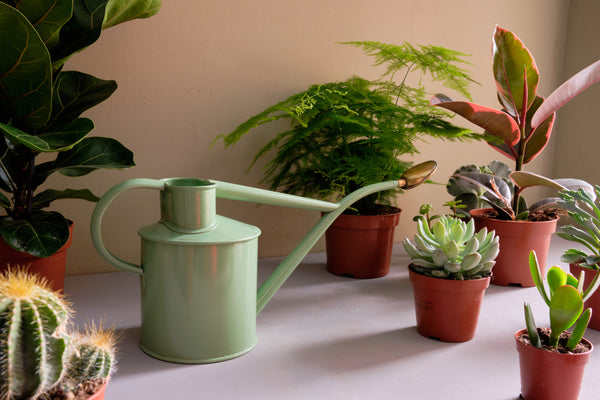A simple guide to watering plants
We all know that water is essential to keep plants alive, but how often and how much is not always so easy to work out. Here’s a few useful tips on watering for a healthy plant.

How to water
It’s generally best to use tepid water. Plants love it when we use water the same temperature as their compost: the soil will absorb it better and you won’t shock them. Most plants can be watered from above using a thin, goose-necked watering can that can easily reach the compost. Wet the compost thoroughly then let the excess water drain away. Do not leave the pot standing in water, as that can cause the roots to rot, which can lead to plant death.
If the soil is very dry, the water you pour will likely rush through the soil and out drainage holes and won’t be absorbed. If that happens, soak the bottom of the plant in water for an hour or so and then drain the excess from the decorative pot or the saucer.
How much and how often
It’s probably not what you want to hear, but there isn’t a standard measure of water that works for every plant, as they’re all unique and can have very different needs. Here is a list of good things to keep in mind when determining how much and how often you need to water your plant.
- Knowing your plant’s natural environment can give you a good indication of its needs. Plants like succulents, cacti and euphorbs are native to arid climates and they like to be quite dry. Give them a thorough soak when the soil is fully dry, but let the soil dry out completely before you do it again (that might take a few weeks, or even a few months in winter time). Many tropical plants, such as Calatheas and Ferns, thrive on higher humidity levels and like their soil to be moist (not soggy) all the time.
- Bigger plants need more water than smaller ones, but smaller plants have less soil and tend to dry out quicker than plants living in bigger pots.
- Don’t stick to a strict schedule. Rather than watering your plants on the same day every week, check the soil to see if they’re actually thirsty. Stick your finger into the soil and go 2 inches deep, if it feels dry it’s time for a drink
- Letting the soil dry out a bit before watering is the key to prevent overwatering.




